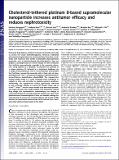| dc.contributor.author | Sengupta, Poulomi | |
| dc.contributor.author | Basu, Sudipta | |
| dc.contributor.author | Soni, Shivani | |
| dc.contributor.author | Pandey, Ambarish | |
| dc.contributor.author | Roy, Bhaskar | |
| dc.contributor.author | Oh, Michael S. | |
| dc.contributor.author | Chin, Kenneth T. | |
| dc.contributor.author | Paraskar, Abhimanyu S. | |
| dc.contributor.author | Sarangi, Sasmit | |
| dc.contributor.author | Connor, Yamicia D. | |
| dc.contributor.author | Sabbisetti, Venkata | |
| dc.contributor.author | Kopparam, Jawahar | |
| dc.contributor.author | Kulkarni, Ashish | |
| dc.contributor.author | Muto, Katherine | |
| dc.contributor.author | Amarasiriwardena, Chitra | |
| dc.contributor.author | Jayawardene, Innocent | |
| dc.contributor.author | Lupoli, Nicola | |
| dc.contributor.author | Dinulescu, Daniela M. | |
| dc.contributor.author | Bonventre, Joseph V. | |
| dc.contributor.author | Mashelkar, Raghunath Anant | |
| dc.contributor.author | Sengupta, Shiladitya | |
| dc.date.accessioned | 2013-02-12T21:22:58Z | |
| dc.date.available | 2013-02-12T21:22:58Z | |
| dc.date.issued | 2012-07 | |
| dc.identifier.issn | 0027-8424 | |
| dc.identifier.issn | 1091-6490 | |
| dc.identifier.uri | http://hdl.handle.net/1721.1/76785 | |
| dc.description.abstract | Nanoscale drug delivery vehicles have been harnessed extensively as carriers for cancer chemotherapeutics. However, traditional pharmaceutical approaches for nanoformulation have been a challenge with molecules that exhibit incompatible physicochemical properties, such as platinum-based chemotherapeutics. Here we propose a paradigm based on rational design of active molecules that facilitate supramolecular assembly in the nanoscale dimension. Using cisplatin as a template, we describe the synthesis of a unique platinum (II) tethered to a cholesterol backbone via a unique monocarboxylato and O→Pt coordination environment that facilitates nanoparticle assembly with a fixed ratio of phosphatidylcholine and 1,2-distearoyl-sn-glycero-3-phosphoethanolamine-N-[amino (polyethylene glycol)-2000]. The nanoparticles formed exhibit lower IC50 values compared with carboplatin or cisplatin in vitro, and are active in cisplatin-resistant conditions. Additionally, the nanoparticles exhibit significantly enhanced in vivo antitumor efficacy in murine 4T1 breast cancer and in K-RasLSL/+/Ptenfl/fl ovarian cancer models with decreased systemic- and nephro-toxicity. Our results indicate that integrating rational drug design and supramolecular nanochemistry can emerge as a powerful strategy for drug development. Furthermore, given that platinum-based chemotherapeutics form the frontline therapy for a broad range of cancers, the increased efficacy and toxicity profile indicate the constructed nanostructure could translate into a next-generation platinum-based agent in the clinics. | en_US |
| dc.description.sponsorship | United States. Dept. of Defense (Breast Cancer Research Program Era of Hope Scholar Award W81XWH-07-1- 0482) | en_US |
| dc.description.sponsorship | United States. Dept. of Defense (Collaborative Innovator Grant) | en_US |
| dc.description.sponsorship | National Institutes of Health (U.S.) (Grant R01 CA135242-01A2) | en_US |
| dc.description.sponsorship | Medical Foundation, inc. (Charles A. King Trust Postdoctoral Research Fellowship Program) | en_US |
| dc.description.sponsorship | United States. Dept. of Defense (Breast Cancer Research Program Postdoctoral Fellowship Award) | en_US |
| dc.description.sponsorship | Dana-Farber/Harvard Cancer Center (Ovarian Cancer SPORE award) | en_US |
| dc.description.sponsorship | Canary Foundation | en_US |
| dc.description.sponsorship | Mary Kay Foundation | en_US |
| dc.description.sponsorship | V Foundation for Cancer Research | en_US |
| dc.language.iso | en_US | |
| dc.publisher | National Academy of Sciences (U.S.) | en_US |
| dc.relation.isversionof | http://dx.doi.org/10.1073/pnas.1203129109 | en_US |
| dc.rights | Article is made available in accordance with the publisher's policy and may be subject to US copyright law. Please refer to the publisher's site for terms of use. | en_US |
| dc.source | PNAS | en_US |
| dc.title | Cholesterol-tethered platinum II-based supramolecular nanoparticle increases antitumor efficacy and reduces nephrotoxicity | en_US |
| dc.type | Article | en_US |
| dc.identifier.citation | Sengupta, P. et al. “Cholesterol-tethered Platinum II-based Supramolecular Nanoparticle Increases Antitumor Efficacy and Reduces Nephrotoxicity.” Proceedings of the National Academy of Sciences 109.28 (2012): 11294–11299. Web. | en_US |
| dc.contributor.department | Harvard University--MIT Division of Health Sciences and Technology | en_US |
| dc.contributor.mitauthor | Connor, Yamicia D. | |
| dc.contributor.mitauthor | Sengupta, Shiladitya | |
| dc.relation.journal | Proceedings of the National Academy of Sciences of the United States of America | en_US |
| dc.eprint.version | Final published version | en_US |
| dc.type.uri | http://purl.org/eprint/type/JournalArticle | en_US |
| eprint.status | http://purl.org/eprint/status/PeerReviewed | en_US |
| dspace.orderedauthors | Sengupta, P.; Basu, S.; Soni, S.; Pandey, A.; Roy, B.; Oh, M. S.; Chin, K. T.; Paraskar, A. S.; Sarangi, S.; Connor, Y.; Sabbisetti, V. S.; Kopparam, J.; Kulkarni, A.; Muto, K.; Amarasiriwardena, C.; Jayawardene, I.; Lupoli, N.; Dinulescu, D. M.; Bonventre, J. V.; Mashelkar, R. A.; Sengupta, S. | en |
| dc.identifier.orcid | https://orcid.org/0000-0002-5436-389X | |
| mit.license | PUBLISHER_POLICY | en_US |
| mit.metadata.status | Complete | |
